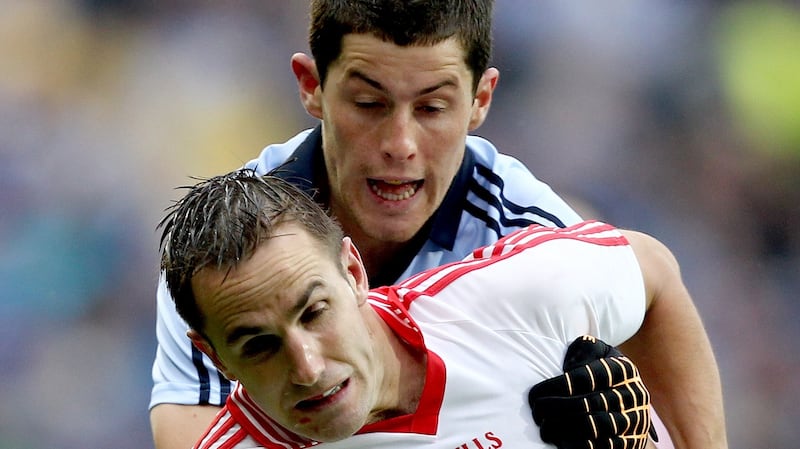On Sunday it comes around. Just under 12 years ago, Pat Gilroy took Dublin footballers on the trip to Healy Park in Omagh. For the first time in over a decade they were challenging for a Division One title and a win could put them in the final.
For Tyrone the stakes were as high – if not higher – in that they needed a win to avoid the first relegation of Mickey Harte’s management. It’s easy to forget at this remove how formidable the county had become in what was roughly the first half of the Harte years.
As soon as he took over in 2002, the new manager was emphasising the need to contest everything – in his 18 seasons they even won 12 McKenna Cups. There would be no challenge matches and the emphasis on collective training dialled down so that players could manage their time more efficiently.
They played league for keeps, not necessarily winning it but making sure that they were one of the leading teams every season. Dublin’s win that day in 2010 meant the end of their opponents’ top-flight status for the first time since 1995, a status blow that Harte in particular – given his priorities – felt deeply.
“It’s very disappointing to leave this division after being in it so long but we’re going to have to come to terms with it and move on,” said Harte. “ You want to be in the top division, we always strive to be there, in fact we strive to win it. We’re far from that position at the minute so we’re not happy.”
In the decade that followed, Harte’s teams would not win any further All-Irelands and became no strangers to defeat in the province, but they were nonetheless frequently the last Ulster county standing in the championship.
Anyway, it was a big deal for Dublin. They had previously won league matches against Tyrone, including in Healy Park – notably the preposterous ‘Battle of Omagh’ in 2006 – but on this occasion they knew that there could be no question but that their opponents would turn up.
It was a genuinely impressive Dublin performance. In those times, whenever they did well there was still a sense that they weren’t serious contenders at the very top level. Even when they nearly beat Tyrone in the 2005 championship, it merely served as a half-time diagnostic for Harte to reconfigure his team into an All-Ireland winning unit.

I remember a friend told me that his work colleagues had been laughing at my report and enthusiasm for Dublin’s trajectory – on the basis that this was akin to some dope being taken yet again by a three-card trick man at the annual fair.
Dublin didn't make the final that year because Mayo beat Cork and the two of them would contest the 2010 league final but there was plenty going on. Defence had been overhauled and although it took a traumatic five-goal glitch against Meath to settle the system, the dynamic between Rory O'Carroll and Cian O'Sullivan was impressive. And that day in Omagh was the first time that season that Alan and Bernard Brogan had appeared together in the attack and they amassed 1-9 between them.
Bernard concentrated on points, scoring eight – six from play – and was the goal provider with two assists, including one for his brother.
Dublin were on their way and as it turned out, the win in Omagh prefaced All-Ireland quarter-final defeats of Tyrone in the next two championships. Within 18 months they were All-Ireland champions.
Harte never quite went away, though. In Jim Gavin’s otherwise triumphant first season, the only setback, league or championship, came in March against Tyrone and for the remainder of the decade, Harte’s teams were the only ones to break even with Dublin in the league.
In the championship it was a different matter and Dublin won all six matches, including arguably the team’s high-water mark, the 2017 All-Ireland semi-final when Tyrone’s cautious defensive system was dismantled. A year later the Super 8 meeting in Omagh was one of the high points of the now abandoned structure – a tense, claustrophobic face-off, won narrowly by Dublin.
In Dessie Farrell’s first season, his team lost in Omagh just before the pandemic struck. This Sunday, he’s back and bringing a side low on confidence and short of ideas.
Unlike their predecessors of 12 years ago, they don’t come with that classic blend: a cadre of experienced players, seasoned by frequent disappointment, to drive and to complement confident and ambitious newcomers.
The ideal, incremental introduction of players into strong line-ups hasn’t been possible for Farrell, as his most senior personnel are either rehabbing injuries or struggling for form and the rookies are effectively being asked to stake their claim on the deck of a sinking ship.
One thing in common with 2010 is that Tyrone need the result badly themselves. They have matters in their own hands but are uncomfortably poised at the wrong end of the table.
One thing they’ve never done is retain the Sam Maguire so in a way they’ve bigger fish to fry whereas Dublin are by now on few shortlists to register a material impact on the championship.
Maybe Tyrone can take solace from the fact that just one county in over 20 years has been relegated as champions, Donegal in 2013. Perhaps, more to the point it’s well over a quarter of a century since any relegated team went on to win that year’s All-Ireland.
Dublin went down in 1995 but in a notable triumph of perseverance, they finally won Sam Maguire a few months later. Dessie Farrell was on that team and needs his successors to locate some of that perseverance this coming weekend.
smoran@irishtimes.com













